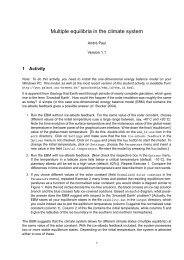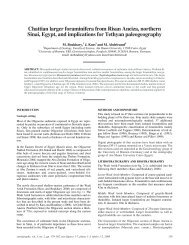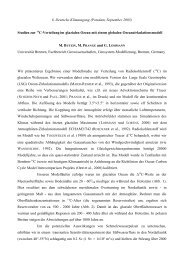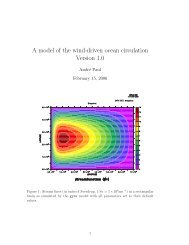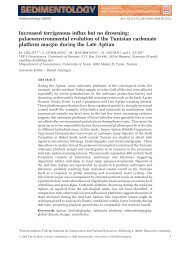Forschung im HLRN-Verbund 2011
Forschung im HLRN-Verbund 2011
Forschung im HLRN-Verbund 2011
- Keine Tags gefunden...
Sie wollen auch ein ePaper? Erhöhen Sie die Reichweite Ihrer Titel.
YUMPU macht aus Druck-PDFs automatisch weboptimierte ePaper, die Google liebt.
120A matter of disorderOxidized silicon nanowires as biomolecular sensors: ab initio structural andelectronic analysisL. Colombi Ciacchi, Hybrid Materials InterfacesGroup, Faculty of Production Engineering and BremenCenter for Computational Materials Science,University of BremenAbstract• Silicon nanowires are widely used as active functionalelements in advanced electronic devices,most notably in biological sensors.• While surface oxidation of the wires occurs uponexposure to a wet environment, theoretical studiesare often l<strong>im</strong>ited to ideally crystalline, H-terminated wire models.• We are performing accurate computational studiesof the electronic and transport propertiesof natively oxidized, ultrathin silicon nanowiresincluding dopant elements such as boron andphosphorous.• We found that their conductance is determinedby an unexpected interplay of effects due tooxidation-induced structural distortions and electronegativeSi/SiO x interfaces.One of the major goals of the semiconductor industryis to continue scaling down the size of electroniccomponents and place more and more transistorsin a single silicon chip. This is necessary to followthe famous Moore’s Law, which predicts the evolutionof computer speed over the years based ondevice miniaturization. However, there are intrinsicl<strong>im</strong>its to the device sizes reached by purely lithographicprocesses, or other so-called “top-down”technologies. These are both connected with exponentiallyrising costs and with physical laws (e.g.when entering a quantum-tunneling reg<strong>im</strong>e), andmotivate the scientific and technological communitiesto search for novel devices and novel fabricationtechniques.Starting from the other end of the scale, severaltypes of “bottom-up” approaches have beenenvisaged, all based on the controlled assembly ofnano-scale building blocks into well-defined functionaldevices [1]. Silicon nanowires (SiNWs) areone of the most promising nanostructures developedso far and are becoming fundamental componentsin a new generation of mixed top-down andbottom-up electronic devices with <strong>im</strong>portant applicationse.g. as sensors for biological molecules [2].Due to their compatibility with silicon based technology,silicon nanowires are extensively studiedand numerous exper<strong>im</strong>ents have already characterizedsome of their structural and electronic properties[3]. Currently synthesized SiNWs presentsurfaces passivated either by hydrogen atoms orby a thin native oxide layer, and their conductionproperties are modified by choosing an appropriatetype and concentration of foreign atoms calleddopants, usually P or B, which carry an additionalelectron or hole (the carriers for electric current).Several theoretical studies have been undertakento characterize the electronic properties ofdifferent SiNWs structures. However, the lack ofa realistic model for Si/SiO 2 core-shell structuresexplains why most studies to date have focused onthe properties of either bare, unpassivated wires orof wires whose surfaces are saturated with hydrogenatoms. This is the origin of a gap between thetheoretical predictions made so far and the exper<strong>im</strong>entalreality, where the <strong>im</strong>portance of consideringthe effects of surface oxidation is felt in numerousapplications. In the typical cases of biological detection,the wet environment in which the devicesoperate leads to the formation of an ultrathin hydratedoxide layer. In electronic devices such asFinFETs the conducting wires are embedded in athicker insulation layer of silicon oxide.In the first part of our project at the <strong>HLRN</strong>, weare currently studying the intrinsic conductance ofB and P doped SiNWs covered with a hydroxylatednative oxide layer. The realistic modellingof a Si/SiO x core-shell wire has been made possibleby extensive previous work, entirely based onatomic-scale s<strong>im</strong>ulations performed on massivelyparallel computers using highly opt<strong>im</strong>ized quantummechanical computer codes (see Ref. [4] and referencestherein). Starting from an oxidised Si(001)flat surface, we have fabricated a natively oxidisednanowire model structure by means of MolecularDynamics s<strong>im</strong>ulations both at the classical and atthe quantum mechanical ab initio level.A key feature of the resulting structure is the intrisicdisorder of the Si core, naturally induced bythe oxidation process. As a first interesting finding,we could prove that the electronic states mostly responsiblefor the conduction of such wires are locatedat the interface between the oxide shell andthe silicon core (see Figure 1). Furthermore, ourcomprehensive total energy calculations have revealedthe most stable sites for B and P dopantatoms. Contrary to our expectations, both types ofatoms prefer to remain buried in the Si core ratherthan segregate near the oxide layer. This is inter-Ingenieurwissenschaften




